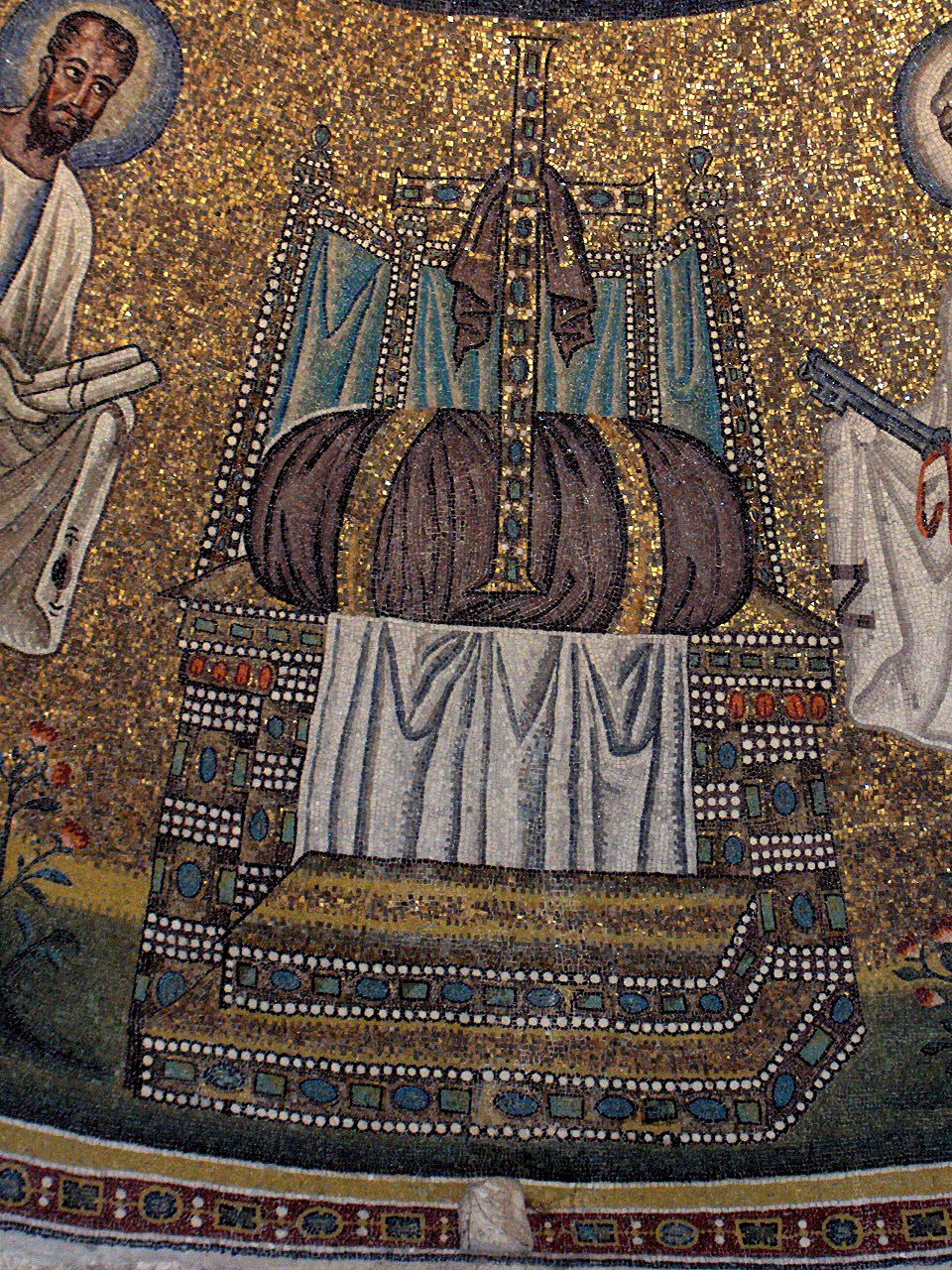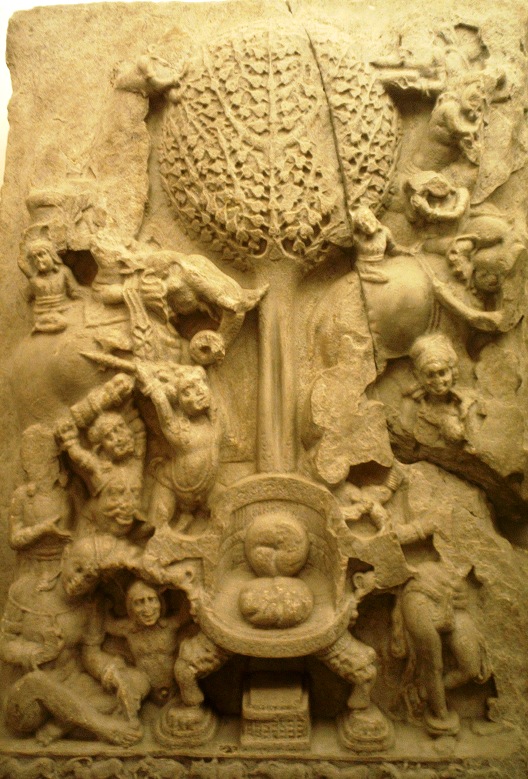|
Hetoimasia
The Hetoimasia, Etimasia (Greek ἑτοιμασία, "preparation"), prepared throne, Preparation of the Throne, ready throne or Throne of the Second Coming is the Christian version of the symbolic subject of the empty throne found in the art of the ancient world, whose meaning has changed over the centuries. In Ancient Greece it represented Zeus, chief of the gods, and in early Buddhist art it represented the Buddha. In Early Christian art and Early Medieval art it is found in both the East and Western churches, and represents either Christ, or sometimes God the Father as part of the Trinity. In the Middle Byzantine period, from about 1000, it came to represent more specifically the throne prepared for the Second Coming of Christ, a meaning it has retained in Eastern Orthodox art to the present. The motif consists of an empty throne and various other symbolic objects, in later depictions surrounded when space allows by angels paying homage. It is usually placed centrally in ... [...More Info...] [...Related Items...] OR: [Wikipedia] [Google] [Baidu] |
Baptistery
In Christian architecture the baptistery or baptistry (Old French ''baptisterie''; Latin ''baptisterium''; Greek , 'bathing-place, baptistery', from , baptízein, 'to baptize') is the separate centrally planned structure surrounding the baptismal font. The baptistery may be incorporated within the body of a church or cathedral, and provided with an altar as a chapel. In the early Church, the catechumens were instructed and the sacrament of baptism was administered in the baptistery. Design The sacramental importance and sometimes architectural splendour of the baptistery reflect the historical importance of baptism to Christians. The octagonal plan of the Lateran Baptistery, the first structure expressly built as a baptistery, provided a widely followed model. The baptistery might be twelve-sided, or even circular as at Pisa. In a narthex or anteroom, the catechumens were instructed and made their confession of faith before baptism. The main interior space centered upon ... [...More Info...] [...Related Items...] OR: [Wikipedia] [Google] [Baidu] |
Aniconism
Aniconism is the absence of artistic representations (''icons'') of the natural and supernatural worlds, or it is the absence of representations of certain figures in religions. It is a feature of various cultures, particularly of cultures which are based on monotheistic Abrahamic religions. The prohibition of material representations may only extend from God and other supernatural beings to saint-like characters, or it may extend to material representations of all living beings, and material representations of everything that exists. The phenomenon is generally codified by religious traditions and as such, it becomes a taboo. When it is enforced by the physical destruction of images, aniconism becomes iconoclasm. Aniconism has been a historical phase in both Buddhism and Christianity, and even though it is much less of an issue today, the attitudes towards religious imagery show considerable variability between different traditions, denominations, and strands within each r ... [...More Info...] [...Related Items...] OR: [Wikipedia] [Google] [Baidu] |
Parasol
An umbrella or parasol is a folding canopy (building), canopy supported by wooden or metal ribs that is usually mounted on a wooden, metal, or plastic pole. It is designed to protect a person against rain or sunburn, sunlight. The term ''umbrella'' is traditionally used when protecting oneself from rain, with ''parasol'' used when protecting oneself from sunlight, though the terms continue to be used interchangeably. Often the difference is the material used for the canopy; some parasols are not waterproof, and some umbrellas are Transparency and translucency, transparent. Umbrella canopies may be made of fabric or flexible plastic. There are also combinations of parasol and umbrella that are called ''en-tout-cas'' (French for "in any case"). Umbrellas and parasols are primarily hand-held portable devices sized for personal use. The largest hand-portable umbrellas are golf umbrellas. Umbrellas can be divided into two categories: fully collapsible umbrellas, in which the metal ... [...More Info...] [...Related Items...] OR: [Wikipedia] [Google] [Baidu] |
Cilicia
Cilicia (); el, Κιλικία, ''Kilikía''; Middle Persian: ''klkyʾy'' (''Klikiyā''); Parthian: ''kylkyʾ'' (''Kilikiyā''); tr, Kilikya). is a geographical region in southern Anatolia in Turkey, extending inland from the northeastern coasts of the Mediterranean Sea. Cilicia has a population ranging over six million, concentrated mostly at the Cilicia plain. The region includes the provinces of Mersin, Adana, Osmaniye, along with parts of Hatay and Antalya. Geography Cilicia is extended along the Mediterranean coast east from Pamphylia to the Nur Mountains, which separates it from Syria. North and east of Cilicia lie the rugged Taurus Mountains that separate it from the high central plateau of Anatolia, which are pierced by a narrow gorge called in antiquity the Cilician Gates. Ancient Cilicia was naturally divided into Cilicia Trachea and Cilicia Pedias by the Limonlu River. Salamis, the city on the east coast of Cyprus, was included in its administrative jurisdictio ... [...More Info...] [...Related Items...] OR: [Wikipedia] [Google] [Baidu] |
Alexander The Great
Alexander III of Macedon ( grc, Ἀλέξανδρος, Alexandros; 20/21 July 356 BC – 10/11 June 323 BC), commonly known as Alexander the Great, was a king of the ancient Greek kingdom of Macedon. He succeeded his father Philip II to the throne in 336 BC at the age of 20, and spent most of his ruling years conducting a lengthy military campaign throughout Western Asia and Egypt. By the age of thirty, he had created one of the largest empires in history, stretching from Greece to northwestern India. He was undefeated in battle and is widely considered to be one of history's greatest and most successful military commanders. Until the age of 16, Alexander was tutored by Aristotle. In 335 BC, shortly after his assumption of kingship over Macedon, he campaigned in the Balkans and reasserted control over Thrace and Illyria before marching on the city of Thebes, which was subsequently destroyed in battle. Alexander then led the League of Corinth, and used his authori ... [...More Info...] [...Related Items...] OR: [Wikipedia] [Google] [Baidu] |
Cherubim
A cherub (; plural cherubim; he, כְּרוּב ''kərūḇ'', pl. ''kərūḇīm'', likely borrowed from a derived form of akk, 𒅗𒊏𒁍 ''karabu'' "to bless" such as ''karibu'', "one who blesses", a name for the lamassu) is one of the unearthly beings who directly attend to God, according to Abrahamic religions. The numerous depictions of cherubim assign to them many different roles, such as protecting the entrance of the Garden of Eden. Abrahamic religious traditions In Jewish angelic hierarchy, cherubim have the ninth (second-lowest) rank in Maimonides' '' Mishneh Torah'' (12th century), and the third rank in Kabbalistic works such as '' Berit Menuchah'' (14th century). ''De Coelesti Hierarchia'' places them in the highest rank alongside Seraphim and Thrones. In the Book of Ezekiel and (at least some) Christian icons, the cherub is depicted as having two pairs of wings, and four faces: that of a lion (representative of all wild animals), an ox ( domestic anim ... [...More Info...] [...Related Items...] OR: [Wikipedia] [Google] [Baidu] |
Ark Of The Covenant
The Ark of the Covenant,; Ge'ez: also known as the Ark of the Testimony or the Ark of God, is an alleged artifact believed to be the most sacred relic of the Israelites, which is described as a wooden chest, covered in pure gold, with an elaborately designed lid called the mercy seat. According to the Book of Exodus, the Ark contained the two stone tablets of the Ten Commandments. According to the New Testament Book of Hebrews, it also contained Aaron's rod and a pot of manna. The biblical account relates that approximately one year after the Israelites' exodus from Egypt, the Ark was created according to the pattern given to Moses by God when the Israelites were encamped at the foot of Mount Sinai. Thereafter, the gold-plated acacia chest was carried by its staves by the Levites approximately 2,000 cubits (approximately ) in advance of the people when on the march. God spoke with Moses "from between the two cherubim" on the Ark's cover. Biblical account Construc ... [...More Info...] [...Related Items...] OR: [Wikipedia] [Google] [Baidu] |
Israelite
The Israelites (; , , ) were a group of Semitic-speaking tribes in the ancient Near East who, during the Iron Age, inhabited a part of Canaan. The earliest recorded evidence of a people by the name of Israel appears in the Merneptah Stele of ancient Egypt, dated to about 1200 BCE. According to the modern archaeological account, the Israelites and their culture branched out of the Canaanite peoples and their cultures through the development of a distinct monolatristic—and later monotheistic—religion centred on the national god Yahweh.Mark Smith in "The Early History of God: Yahweh and Other Deities of Ancient Israel" states "Despite the long regnant model that the Canaanites and Israelites were people of fundamentally different culture, archaeological data now casts doubt on this view. The material culture of the region exhibits numerous common points between Israelites and Canaanites in the Iron I period (c. 1200–1000 BCE). The record would suggest that the Isra ... [...More Info...] [...Related Items...] OR: [Wikipedia] [Google] [Baidu] |
Etruscans
The Etruscan civilization () was developed by a people of Etruria in ancient Italy with a common language and culture who formed a federation of city-states. After conquering adjacent lands, its territory covered, at its greatest extent, roughly what is now Tuscany, western Umbria, and northern Lazio, as well as what are now the Po Valley, Emilia-Romagna, south-eastern Lombardy, southern Veneto, and western Campania. The earliest evidence of a culture that is identifiably Etruscan dates from about 900BC. This is the period of the Iron Age Villanovan culture, considered to be the earliest phase of Etruscan civilization, which itself developed from the previous late Bronze Age Proto-Villanovan culture in the same region. Etruscan civilization endured until it was assimilated into Roman society. Assimilation began in the late 4thcenturyBC as a result of the Roman–Etruscan Wars; it accelerated with the grant of Roman citizenship in 90 BC, and became complete in 27 BC, ... [...More Info...] [...Related Items...] OR: [Wikipedia] [Google] [Baidu] |
Hittites
The Hittites () were an Anatolian people who played an important role in establishing first a kingdom in Kussara (before 1750 BC), then the Kanesh or Nesha kingdom (c. 1750–1650 BC), and next an empire centered on Hattusa in north-central Anatolia (around 1650 BC). This empire reached its height during the mid-14th century BC under Šuppiluliuma I, when it encompassed an area that included most of Anatolia as well as parts of the northern Levant and Upper Mesopotamia. Between the 15th and 13th centuries BC, the Empire of Hattusa—in modern times conventionally called the Hittite Empire—came into conflict with the New Kingdom of Egypt, the Middle Assyrian Empire and the empire of Mitanni for control of the Near East. The Middle Assyrian Empire eventually emerged as the dominant power and annexed much of the Hittite Empire, while the remainder was sacked by Phrygian newcomers to the region. After BC, during the Late Bronze Age collapse, the Hittites splintered in ... [...More Info...] [...Related Items...] OR: [Wikipedia] [Google] [Baidu] |








